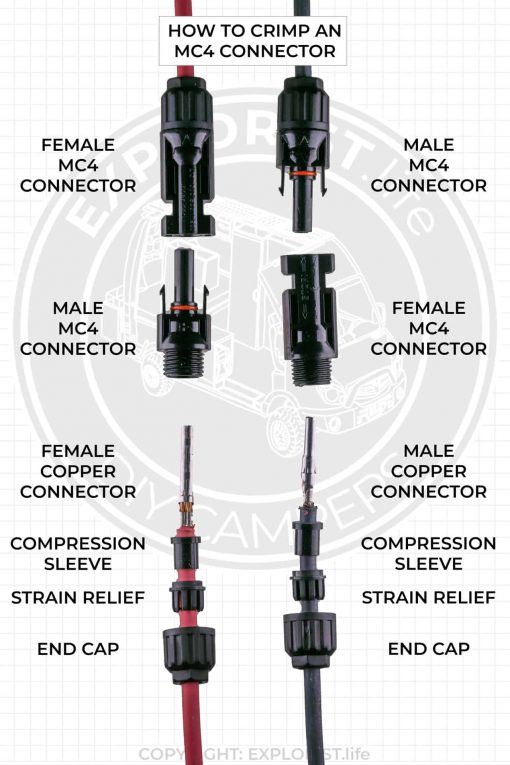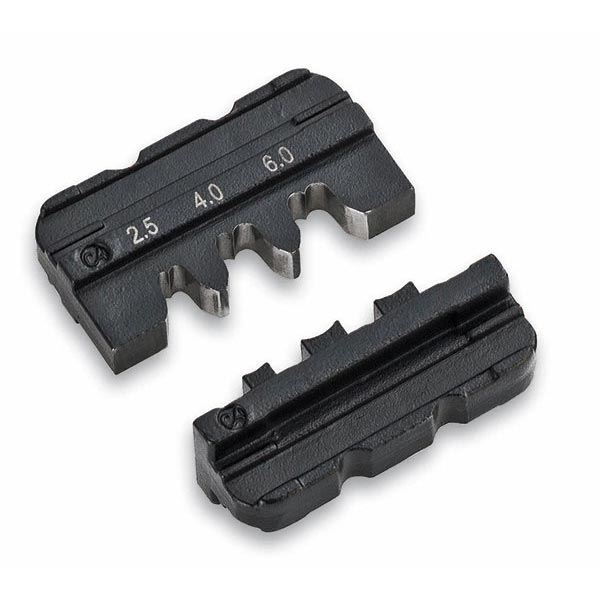

There are a lot of “MC4-compatible” connectors on the market that are not made by Multi-Contact.
#Crimping mc4 connectors code
The National Electric Code Article 690 addresses every aspect of solar power systems (link provided at the end of this article). Most of what is offered for sale as “solar panel wire,” “photovoltaic wire,” or similar nomenclature already meets NEC requirements and will work just fine.

You do not need to spend endless hours of research to find the correct wire. HINT: Don’t make this harder than it has to be. Ordinary 10 gauge wire is electrically identical to NEC approved PV wire and will technically work but is not UV resistant and not approved for outdoor use. PV wire comes in red and black and will last many years in an outdoor environment but is considerably more expensive than standard copper wire. Stranded 10 gauge wire that meets National Electric Code (NEC), Article 690, USE-2 for photovoltaic applications, and Underwriter’s Laboratory (UL) standards for UV resistance and insulation thermal tolerance is acceptable. They are made of plastic and easy to find for less than $10 for a pair. In addition to the crimp tool you will also need two disconnect/spanner wrench combo tools.

Some of the lower priced crimp tools do not have this feature and should be avoided. This will help make your terminations uniform and on spec. The exact make and model is not important as long as it has a hinged, swing out contact holder. There are plenty of good ones in the $30-$60 range. MC4 connector crimp tools vary widely in price, from less than $20 up to several hundred dollars. The only must-haves for installing MC4 connectors is a crimp tool and two disconnect/spanner wrench combo tools. Many on line retailers sell kits that usually include a lot of extras you may not need or want. Working with MC4 connectors requires a few specialized tools. Connectors using these clips cannot be squeezed apart by hand you must release them with the disconnect tool. Some versions of MC4 have a removable “safety lock clip” that covers the interlock tabs and provides additional unintentional disconnect protection. To disconnect, squeeze the two interlocks together and pull the connectors apart. The male version uses a different housing and metal contact, but the rest of the parts are interchangeable. There are five parts to an MC4 connector (from right to left in the photo above): the main housing, a metal crimp contact, a rubber water seal, a seal retainer, and a screw on end cap. If you insist on using Power Poles, make an adapter with an MC4 on one end and a Power Pole on the other. Do not do this! Power Poles are not designed for long term outdoor use, and you will have a solar panel that is not compatible with any other solar panel.

Some hams will cut the MC4 connectors off the solar panel and replace them with Anderson Power Poles. They are found on nearly every solar panel greater than 20 watts. The MC4 connector fits the need perfectly. Larger panels or panels that are designed to be wired together in an array need a standardized termination that can handle higher power levels. These panels do not produce high currents and are intended to be used as stand-alone units, so the method of termination is not really important. Small solar panels under 20 watts typically use screw/spring terminals or some type of automotive electrical connector. They are also weather resistant, UV proof, and designed for continuous outdoor use. The interlock prevents the cables from being unintentionally pulled apart. MC4 connectors terminate to each other with a notched interlock that in some situations requires a special tool to disconnect. Suffice it to say that the margin of safety is quite large and more than adequate for any foreseeable project an amateur radio operator may undertake. The maximum current and voltage that can be pushed through MC4 connectors varies by application and the type of wire used. There are many other manufacturers producing clones (why this matters will be discussed later in this article). Multi-Contact is the official manufacturer of MC4 connectors. It is a round plastic housing with a single conductor in a paired male/female configuration developed by the Multi-Contact Corporation. Most larger solar panels come with MC4 connectors already on them. MC4 stands for “Multi-Contact, 4 millimeter” and is a standard in the renewable energy industry. But if you have any aspirations of upgrading to a more powerful or custom built solar energy system, you’ll need be familiar with MC4 connectors. If you have been running small solar panels or a kit system, all of the real work is done for you.


 0 kommentar(er)
0 kommentar(er)
